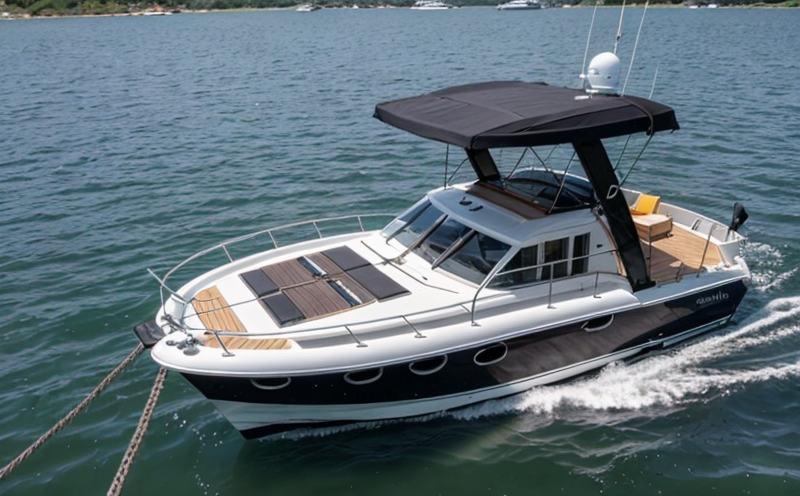ISO 6482 Dynamic Load Testing of Marine Cranes
The International Organization for Standardization (ISO) has established ISO 6482:2017, which specifies the requirements and procedures for determining the dynamic load capacity of marine cranes. This standard is particularly crucial for ensuring that marine cranes, used extensively in maritime operations, are capable of handling their intended loads safely under real-world conditions.
Dynamic load testing focuses on evaluating a crane’s performance under varying stress conditions as it moves and lifts heavy payloads. These tests help identify potential weaknesses or design flaws that could compromise the integrity of the equipment during critical tasks such as cargo loading/unloading, ship repair, or rescue operations at sea.
The primary goal is to ensure that all components—such as hoists, hooks, pulleys, and lifting chains—are functioning correctly under dynamic forces. This includes assessing not just static loads but also the effects of inertia and oscillation during rapid movements.
Marine cranes are subject to harsh environmental conditions including saltwater exposure, extreme temperatures, and frequent operation in windy or rough seas. Therefore, their design must account for these factors while maintaining high levels of reliability and safety. Compliance with ISO 6482 ensures that manufacturers meet international standards, thereby protecting operators from potential hazards.
Our laboratory specializes in conducting dynamic load tests according to ISO 6482, providing detailed reports on each test conducted. We employ state-of-the-art equipment capable of simulating realistic loading scenarios experienced by marine cranes during actual operations. This ensures accurate and reliable assessment results that can be used for certification purposes or as part of an ongoing quality assurance program.
Dynamic load testing plays a vital role in preventing accidents aboard ships, which could result from improperly functioning crane systems. By adhering to this international standard, we contribute significantly towards enhancing safety standards within the maritime industry.
Why It Matters
The importance of ISO 6482 dynamic load testing cannot be overstated, especially given the critical nature of marine operations where even minor equipment failures can lead to catastrophic consequences. The maritime sector relies heavily on cranes for various tasks ranging from cargo handling to emergency response activities.
- Enhanced Safety: Testing ensures that all components work together seamlessly under dynamic conditions, reducing risks associated with operational errors or mechanical malfunctions.
- Compliance Assurance: Adherence to international standards like ISO 6482 guarantees compliance with regulatory requirements, which is essential for maintaining good standing in the industry.
- Informed Decision-Making: Detailed test reports provide valuable insights into how well a crane performs under different stress levels. This information can be used by procurement teams to make informed decisions about purchasing new equipment or upgrading existing assets.
By incorporating ISO 6482 testing into your maintenance and inspection protocols, you demonstrate commitment to safety and quality within the maritime sector. It also helps build trust among stakeholders, including clients, regulatory bodies, and insurance providers.
Quality and Reliability Assurance
Our laboratory adheres strictly to ISO 6482 guidelines during dynamic load testing of marine cranes. Here’s a brief overview of the key steps involved:
- Preparation: Specimens are carefully prepared according to specific criteria outlined in the standard. This includes ensuring that all parts are clean, free from corrosion, and correctly assembled.
- Instrumentation Setup: We use advanced sensors and data acquisition systems to monitor critical parameters during testing. These include load cells, strain gauges, accelerometers, etc., which provide real-time feedback on the performance of each component.
- Testing Procedure: The actual test involves applying a series of dynamic loads while simultaneously measuring various characteristics like acceleration, displacement, and stress distribution within the crane structure. This helps us determine whether any part exceeds safe limits or shows signs of wear and tear.
- Data Analysis: All collected data is rigorously analyzed using sophisticated software tools to ensure accuracy and consistency with expected outcomes based on ISO 6482 requirements.
The final report summarizes findings, highlighting any areas requiring attention along with recommendations for corrective actions if necessary. Our team of experts interprets these results into actionable insights that can help improve overall equipment performance or extend service life through targeted maintenance efforts.
Environmental and Sustainability Contributions
Incorporating ISO 6482 compliant testing contributes positively to both environmental protection and sustainability goals within the maritime industry. By ensuring that all cranes operate efficiently and safely, we reduce the likelihood of accidents leading to oil spills or other pollution incidents at sea.
Efficient operation also translates into lower fuel consumption when performing tasks like cargo handling or shipyard work. Additionally, reliable equipment means less downtime, allowing vessels to stay operational longer without interruptions—a key factor in reducing carbon emissions associated with idling or delayed operations.
Furthermore, adherence to this international standard demonstrates our commitment to sustainable practices within the sector. This aligns well with broader industry initiatives aimed at minimizing ecological impact while promoting responsible resource utilization.





